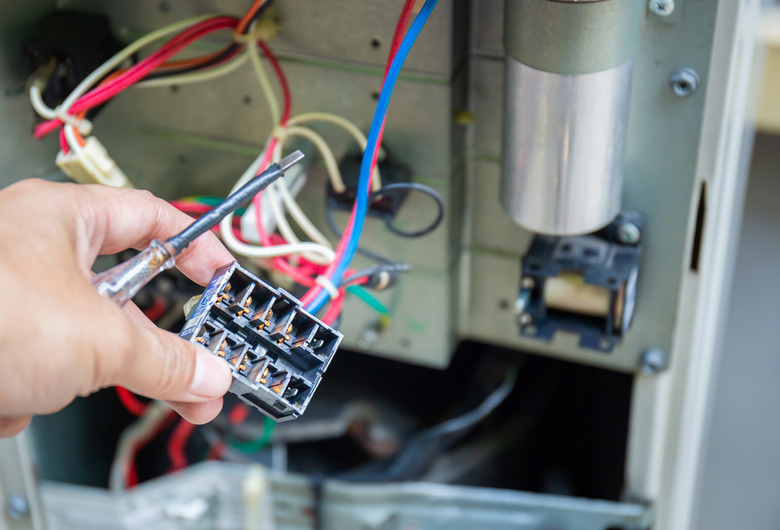How Do Transformers Work In HVAC Units?
We may receive a commission on purchases made from links.
HVAC stands for heating, ventilation and air conditioning, and as the acronym suggests, an HVAC system can perform one function or many functions. The most common are heating via a furnace and air conditioning via a combination indoor/outdoor unit, but some systems consist of a reversible heat pump that does the jobs of both heating and cooling. No matter what the system, it has a number of sensitive relays, controllers and switches to ensure all its parts work in the proper sequence to keep your home comfortable.
While the system components, such as the blower, air conditioner compressor and draft-inducing fan, operate at 120 or 240 VAC (AC volts), the controllers are too sensitive for that and function more efficiently at low voltage, usually 24 VAC. It's the job of the transformer, which is usually situated in the control box of the furnace or air handler, to step down the voltage. The transformer is connected to the thermostat, which is the brains of the system and is also a low-voltage device.
Tip
The transformers in HVAC units step down the voltage used for the control panel and thermostat circuitry to 24 volts, which is safer for all the sensitive components.
How a Transformer Works
How a Transformer Works
Michael Faraday, the 19th century British physicist, made transformers possible when he discovered the phenomenon of magnetic induction. To make a long story short, a transformer uses induction to alter the voltage in an AC circuit, and it can either raise it (step it up) or lower it (step it down). An HVAC transformer is a step-down transformer that uses — as all transformers do — a pair of conducting coils wrapped around a metal core.
The primary coil receives the incoming signal, and as electricity passes through it, it induces a magnetic field in the core. That field energizes the secondary, or output, core, which in turn induces an electromotive force in the output coil. The EMF is directly proportional to the number of windings in the coil, so if the coils have different numbers of windings, the voltage in each circuit will be different. This only works with AC current because the electricity has to be in flux to induce a magnetic field.
The Control Circuit Is Isolated
The Control Circuit Is Isolated
The electric signal from the transformer is used by the system to open and close a series of relays and contacts that control the various system functions. The way it operates a particular component, such as the blower motor, is something like this:
The neutral leg of the 24-volt circuit that originates at the transformer is connected to one terminal of a control relay that consists of a coil and a dry-contact switch. The hot leg is fed through the thermostat before connecting to the other relay terminal. When the thermostat switch closes and allows power to flow, it energizes the coil in the relay, which generates a magnetic field that closes the switch. The blower, which is powered by an independent 120- or 240-volt circuit, comes on.
Signs of a Bad Transformer
Signs of a Bad Transformer
As a passive electrical device, it's rare for a transformer to malfunction, and a certain amount of humming is normal. A transformer can malfunction, however, if there is a power surge large enough to damage the coils or wire contacts. When the transformer is damaged, the circuit breaker controlling the system will usually trip to prevent damage to any of the sensitive electronic components of the control system. The breaker can trip for a number of other reasons, and it usually takes an HVAC professional to trace the cause to a bad transformer.
